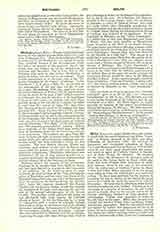

Miltiades, Saint, POPE. The year of his birth is not known; he was elected pope in either 310 or 311; died 10 or January 11, 314. After the banishment of Pope Saint Eusebius (q.v.) the Roman See was vacant for some time, probably because of the complications which had arisen on account of the apostates (lapsi), and which were not cleared up by the banishment of Eusebius and Heraclius. On July 2, 310 or 311, Miltiades (the name is also written Melchiades), a native of Africa, was elevated to the papacy. There is some uncertainty as to the exact year, as the “Liberian Catalogue of the Popes” (Duchesne, “Liber Pontificalis“, I, 9) gives July 2, 311, as the date of the consecration of the new pope (ex die VI non. iul. a cons. Maximiliano VIII solo, quod fuit mense septembri Volusiano et Rufino); but in contradiction to this the death of the pope is said to have occurred on January 2, 314, and the duration of the pontificate is given as three years, six months and eight days;possibly owing to the mistake of a copyist, we ought to read “ann. II” instead of “ann. III”; and therefore the year of his elevation to the papacy was most probably 311. About this time (311 or 310), an edict of toleration signed by the Emperors Galerius, Licinius, and Constantine, put an end to the great persecution of the Christians, and they were permitted to live as such, and also to reconstruct their places of religious worship (Eusebius, “Hist. Eccl.”, VIII, xvii; Lactantius, “De mortibus persecutorum”, xxxiv). Only in those countries of the Orient which were under the sway of Maximinus Daia did the Christians continue to be persecuted. The emperor now gave Pope Miltiades in Rome the right to receive back, through the prefect of the city, all ecclesiastical buildings and possessions which had been confiscated during the persecutions. The two Roman deacons, Strato and Cassianus, were ordered by the pope to discuss this matter with the prefect, and to take over the church properties (Augustinus, “Breviculus collationis cum Donatistis”, iii, 34); it thus became possible to reorganize thoroughly the ecclesiastical administration and the religious life of the Christians in Rome.
Miltiades caused the remains of his predecessor, Eusebius, to be brought back from Sicily to Rome, and had them interred in a crypt in the Catacombs of St. Callistus. In the following year the pope witnessed the final triumph of the Cross, through the defeat of Maxentius, and the entry into Rome of the Emperor Constantine (now converted to Christianity), after the victory at the Milvian Bridge (October 27, 312). Later the emperor presented the Roman Church with the Lateran Palace, which then became the residence of the pope, and consequently also the seat of the central administration of the Roman Church. The basilica which adjoined the palace or was afterwards built there became the principal church of Rome. In 313 the Donatists (q.v.) came to Constantine with a request to nominate bishops from Gaul as judges in the controversy of the African episcopate regarding the consecration in Carthage of the two bishops, Caecilian and Majorinus. Constantine wrote about this to Miltiades, and also to Marcus, requesting the pope with three bishops from Gaul to give a hearing in Rome, to Ciecilian and his opponent, and to decide the case. On October 2, 313, there assembled in the Lateran Palace, under the presidency of Miltiades, a synod of eighteen bishops from Gaul and Italy, which, after thoroughly considering the Donatist controversy for three days, decided in favor of Caecilian, whose election and consecration as Bishop of Carthage was declared to be legitimate. In the biography of Miltiades, in the “Liber Pontificalis“, it is stated that at that time Manichaeans were found in Rome; this was quite possible as Manichaeism began to spread in the West in the fourth century. The same source attributes to this pope a decree which absolutely forbade the Christians to fast on Sundays or on Thursdays, “because these days were observed by the heathen as a holy fast”. This reason is remarkable; it comes most likely from the author of the “Liber Pontificalis” who with this alleged decree traces back a Roman custom of his own time to an ordinance of Miltiades. The “Liber Pontificalis” is probably no less arbitrary in crediting this pope with a decree to the effect that the Oblation consecrated at the Solemn Mass of the pope (by which is meant the Eucharistic Bread) should be taken to the different churches of Rome. Such a custom actually existed in Rome (Duchesne, “Christian Worship,” London, 1903, 185); but there is nothing definite to show that it was introduced by Miltiades, as the “Liber Pontificalis” asserts.
After his death, on 10 or January 11 (the “Liberian Catalogue” gives it as III id. jan.; the “Depositio Episcoporum” as IIII id. ian.), 314, Miltiades was laid to rest in the Catacomb of St. Callistus and he was venerated as a saint. De Rossi regards as highly probable his location of this pope’s burial-chamber (Roma Sotterranea, II, 188 sq.). His feast was celebrated in the fourth century, on January 10, according to the “Martyrologium Hieronymianum”. In the present “Roman Martyrology” it occurs on December 10.
J. P. KIRSCH

